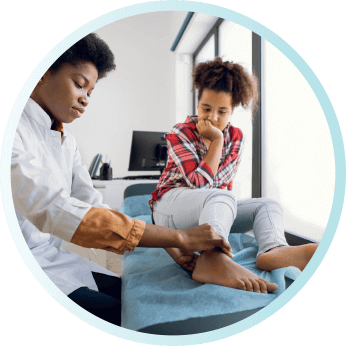Recently enacted and proposed changes to child labor laws in several states have the potential to increase the number of minors in the workforce, but the impact to the workforce remains to be seen (see Child Labor Laws Are Changing: How Could This Impact Workers’ Comp?).
Regardless, it is not uncommon to see a significant population of minors in certain occupations, be it food service, retail, recreational facilities, or other miscellaneous positions.


U.S. teens had a summer job in 20211
teens worked retail jobs in the summer of 20211


Teens make up 24% of the limited-service restaurant workforce2
From a workers’ compensation medical management standpoint, this population is unique for a number of reasons. Specifically, in the event a minor sustains a work-related injury requiring pain management, it is important to understand special pharmacy considerations within this employee population.
When it comes to pharmacy management, medications that are commonly prescribed in workers’ comp to adult patients may not be clinically appropriate for younger individuals, as those drugs may not be adequately studied in pediatric populations.3 Additionally, measuring outcomes among minors may be difficult.3
Furthermore, individuals can progress through adolescence at different rates, meaning two young people of the same age could be at vastly different stages of development, and pharmacotherapy may be even more nuanced when compared to adults.

Therefore, it is worth examining some of the most common drug classes in workers’ comp through the lens of treating pain in younger individuals.
Nonsteroidal anti-inflammatory drugs (NSAIDs) are widely used to treat a variety of different pains and aches for many short and long-term conditions. Commonly used NSAIDs include:
Prescription strength nonsteroidal anti-inflammatory drugs (NSAIDs) are considered safe and effective for the treatment of pain amongst adolescents,4 with the exception of aspirin.
Different medical organizations vary on their opinions, but many would agree that children under the ages of 16-19 should not use aspirin unless instructed by a doctor due to the risk of Reye’s syndrome, a rare but serious condition that is typically preceded by a viral infection like flu or chickenpox, which causes confusion, swelling in the brain, and liver damage.5-6
While generally considered safe, NSAIDs present potential risks that include:
Acetaminophen – also known as the brand drug Tylenol® – is used to treat minor aches and pains in addition to fever.
Acetaminophen is generally considered safe and effective for the treatment of pain in adolescents. However, acetaminophen comes with the same risks and precautions present in adult use.
Potential risks with acetaminophen include:
While acetaminophen can be prescribed by a doctor, OTC availability creates the risk of therapeutic duplication, which creates an even greater risk for adolescents, especially as acetaminophen can be found in other prescription and OTC medications, such as cold medicines.
Research indicates that individuals aged 16-23 have limited and unsafe understandings of acetaminophen use, even when consulting the drug label.7
Acetaminophen’s presence as a well-known drug may create the impression that the drug is harmless, which could lead to misuse and overdose. Therefore, it is important to communicate the potential risks of misuse with adolescents.

Gabapentinoids are anticonvulsant (anti-seizure) drugs used to treat neuropathic (nerve) pain.
Gabapentinoids commonly prescribed in workers’ comp include:
The clinical trials for pregabalin and gabapentin only included children/adolescents for partial-onset seizures and fibromyalgia – these trials did not establish safety and efficacy for the treatment of neuropathic pain in children/adolescents.8-9
Gabapentinoids present the same risks in younger individuals as they do in adults, but at a higher severity. This can include:

Research indicates that children may be at increased risks for adverse events. In a study of nearly 192,000 people from the Swedish Prescribed Drug Register who used gabapentinoids, increased hazards of all outcomes were associated with gabapentinoids for individuals aged 15-24.10
While gabapentinoid use should always be closely monitored, in the case of children it warrants additional attention.
Opioid pain medications that are often utilized in workers’ comp include:
While opioid therapy can be effective in adult populations, it requires close monitoring, as even appropriate use can lead to dependence, addiction, and other adverse events. However, opioid-related concerns with adolescents are even greater.
The Centers for Disease Control and Prevention's (CDC) Clinical Practice Guideline for Prescribing Opioids for Pain notes that the available evidence concerning the benefits and risks of long-term opioid therapy in children and adolescents remains limited, and few opioid medications provide information in their labeling regarding safety and effectiveness in pediatric patients.11

According to the CDC guidelines, recommendations for the use of opioids as pain medications for children are only available for sickle cell disease, for children undergoing surgical procedures, and for palliative care in adolescent and young adult patients with cancer.11
Opioids may be utilized in limited treatment scenarios for adolescents, such as post-surgical pain. However, providers must seriously weigh benefits against elevated risks.
The risks associated with opioid therapy are well known within and beyond the workers’ comp industry due to the opioid epidemic. Opioid-related risks include:
These risks are present for all populations, however younger individuals may be more susceptible to certain opioid-related risks.
A systematic review of over 14,000 clinical articles found that a significant portion of adolescents with access to opioids misuse them.12 Prescriptions from a health care professional are the most common source of opioids for adolescents who misuse them, and of adolescents who misuse prescription opioids, a significant number will develop dependence or opioid use disorders.12
According to findings from Pediatrics, approximately 46% of pediatric opioid prescriptions – defined as prescriptions for individuals aged 0-21 years – are high risk.13
Opioid therapy should only be utilized in younger populations when the benefits outweigh the risks, which would be for particularly severe conditions.
Muscle relaxants are drugs used to alleviate muscle spasms and pain. Several muscle relaxants are Schedule IV drugs. Common muscle relaxants in workers comp include:
Muscle relaxants should only be used short-term, as they present risks such as:

Specific to adolescents, there is a lack of randomized control studies in the pediatric population regarding the use of muscle relaxants.14 However, muscle relaxants can be used as part of a multidisciplinary approach to treat musculoskeletal conditions.14
While all muscle relaxants share some of the same risks, different muscle relaxants possess different risks among adolescent populations.
As the factors impacting worker populations continue to evolve, so do the medical management needs of these populations – and workers’ comp medical programs must remain nimble to effectively address these shifting and unique needs.
Pharmacy management is but one component of managing unique patient populations but remains a significant one to help ensure that injured workers, regardless of their age, remain on the path to recovery in a safe and effective manner.
Key benefits that pharmacy management partners can offer for managing unique patient populations include flexible systems and processes that allow for customizable rules for different patient populations, and the expertise of on-staff clinical pharmacists who can provide unique pharmacotherapy insights that inform both program strategy and individual claims as needed.
